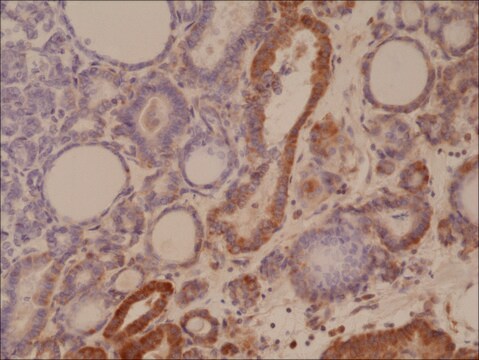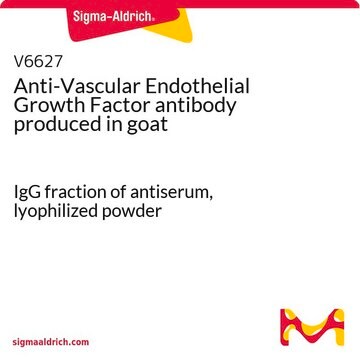추천 제품
생물학적 소스
mouse
결합
unconjugated
항체 형태
ascites fluid
항체 생산 유형
primary antibodies
클론
KDR-1, monoclonal
포함
15 mM sodium azide
종 반응성
human
기술
immunohistochemistry (frozen sections): 1:800 using human placenta
indirect ELISA: suitable
동형
IgG1
UniProt 수납 번호
배송 상태
dry ice
저장 온도
−20°C
타겟 번역 후 변형
unmodified
유전자 정보
human ... KDR(3791)
일반 설명
Monoclonal Anti-Vascular Endothelial Growth Factor Receptor-2 (mouse IgG1 isotype) is derived from the KDR-1 hybridoma produced by the fusion of mouse myeloma cells and splenocytes from an immunized mouse. Vascular endothelial growth factor (VEGF), is a homodimeric heparin-binding glycoprotein. It is a member of a family of endothelial cell mitogenic and angiogenic factors. The VEGFR2 gene has been mapped to human chromosome 4q11-q12, which is the same locus for PDGF receptor and c-kit.
The antibody reacts specifically with VEGF receptor 2 (KDR) and does not recognize VEGF receptor-1 (Flt1 receptor), VEGF receptor 3 (sFlt4), and PDGF-Rβ.
면역원
recombinant human extracellular domain of VEGFR-2 (KDR).
애플리케이션
Monoclonal Anti-Vascular Endothelial Growth Factor Receptor-2 antibody produced in mouse has been used in:
- immunohistochemistry
- histology
- immunostaining
- enzyme linked immunosorbent assay (ELISA)
Monoclonal Anti-Vascular Endothelial Growth Factor Receptor-2 antibody produced in mouse was used for FACS analysis of HUVECs.
생화학적/생리학적 작용
Vascular endothelial growth factor (VEGF) specifically stimulates the proliferation of endothelial cells isolated from both small and large vessels. These include endothelial cells from adrenal cortex, cerebral cortex, fetal and adult aorta and human umbilical vein.
Vascular endothelial growth factors receptors (VEGF Rs) are receptor tyrosine kinases that bind to VEGF. VEGF plays an important role in embryonic vasculogenesis, angiogenesis and homeostasis. The binding of VEGF to VEGF R2 results in activation of MAPK, PI3K, PKC, FAK and Src kinase pathways. The biological roles of VEGF R2 include in epithelial cell growth, proliferation, survival, migration, vascular permeability and angiogenesis.
면책조항
Unless otherwise stated in our catalog or other company documentation accompanying the product(s), our products are intended for research use only and are not to be used for any other purpose, which includes but is not limited to, unauthorized commercial uses, in vitro diagnostic uses, ex vivo or in vivo therapeutic uses or any type of consumption or application to humans or animals.
적합한 제품을 찾을 수 없으신가요?
당사의 제품 선택기 도구.을(를) 시도해 보세요.
Storage Class Code
10 - Combustible liquids
WGK
WGK 1
Flash Point (°F)
Not applicable
Flash Point (°C)
Not applicable
Vascular endothelial growth factor (VEGF) is an autocrine growth factor for VEGF receptor-positive human tumors
Masood R, et al.
Blood, 98(6), 1904-1913 (2001)
Axitinib affects cell viability and migration of a primary foetal lung adenocarcinoma culture
Menna C, et al.
Cancer Investigation, 32(1), 13-21 (2014)
Neuropilin-1 promotes VEGFR-2 trafficking through Rab11 vesicles thereby specifying signal output
Ballmer-Hofer K, et al.
Blood, 118(3), 816-826 (2011)
Chie-Pein Chen et al.
Stem cells (Dayton, Ohio), 26(2), 550-561 (2007-11-03)
Maternal cells can become engrafted in various fetal organs during pregnancy. The nature of the cells and the mechanisms of maternofetal cell trafficking are not clear. We demonstrate that human lineage-negative, CD34-negative (Lin(-)CD34(-)) multipotent mesenchymal stromal cells express alpha(2), alpha(4)
Markus Meissner et al.
Circulation research, 94(3), 324-332 (2003-12-20)
Peroxisome proliferator-activated receptors (PPARs) are ligand-activated transcription factors, originally implicated in the regulation of lipid and glucose homeostasis. In addition, natural and synthetic PPAR activators may control inflammatory processes by inhibition of distinct proinflammatory genes. As signaling via the vascular
자사의 과학자팀은 생명 과학, 재료 과학, 화학 합성, 크로마토그래피, 분석 및 기타 많은 영역을 포함한 모든 과학 분야에 경험이 있습니다..
고객지원팀으로 연락바랍니다.








